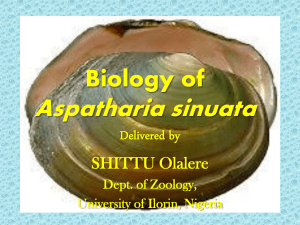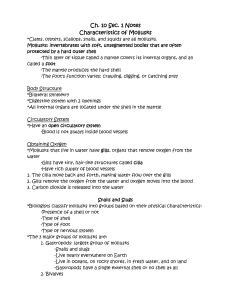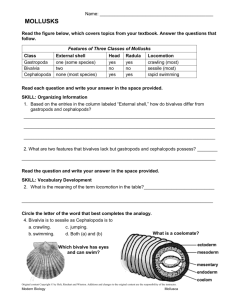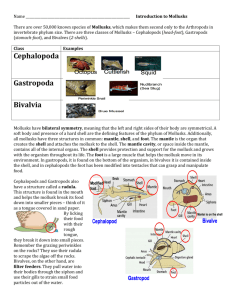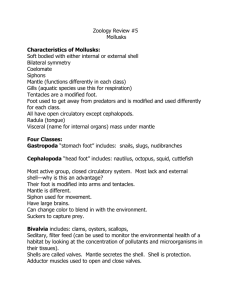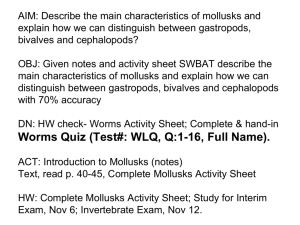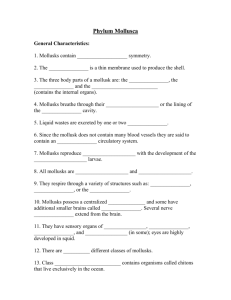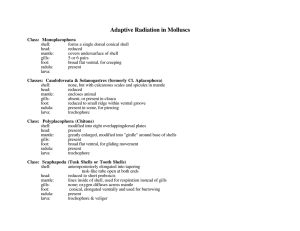Honors Marine Biology Module 5 Bivalves Clam and Squid dissection
advertisement
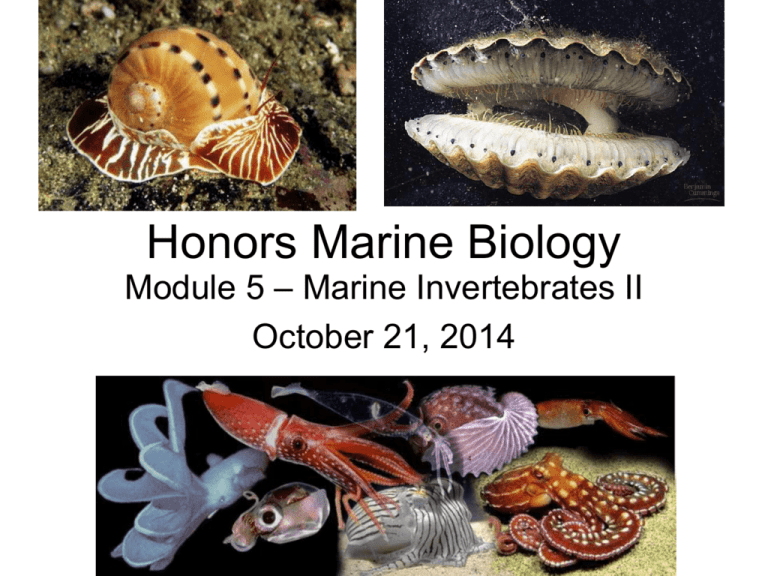
Honors Marine Biology Module 5 – Marine Invertebrates II October 21, 2014 Class Challenge Your best impersonation Quiz Define and give an example for the following: mutualism, commensalism, parasitism. Mutualism: A relationship between two or more organisms of different species where both benefit from the association. A bee and a flower Commensalism: A relationship between two or more organisms of different species where one benefits and the other is neither harmed nor benefited. Barnacles on the fin of a whale Parasitism: A relationship between two or more organisms of different species where one benefits and the other is harmed. A tick, mosquito or a tapeworm on an animal Homeschool Days at Mote Marine See the October 6, 2014 wavemakersrq.wordpress.com post that has the schedule. Marine Invertebrates Four Major Phyla: 1. 2. 3. 4. Mollusca: Arthropoda Echinodermata Chordata Phylum Mollusca And commonly called Mollusks, and represent the most species in the ocean than any other group. They include clams, abalone, cone shells, squid and octopuses. Most mollusks have a bilaterally symmetric soft body protected by a shell made of calcium carbonate. The shell provides protection from the elements and predators and can also provide body support. Mantle The soft body is covered by a mantle, which is a sheath of tissue surrounding the organs of a mollusk, producing the mollusk’s shell and preforming respiration. Foot Many mollusks use a large, muscular foot for locomotion, anchoring, or obtaining food. They also have a series of sensory organs near their heads. Gills Are used for exchanging gases with the surrounding water. Mollusks also have a digestive tract, and a somewhat complex nervous system. A special organ allows these organisms to scrape food into their mouths is called a radula. It is covered with hundreds of small teeth, used for scraping food into the mouth. Class Gastropod (Figure 5.1) The head of a gastropoda is very complex compared to that of most other mollusks. Many of the species have eyes on the tips of their tentacles. Gastropods have several feeding strategies. Some have radula to scrape algae off rocks, like the limpet and abalones. Nudibranch • Have no shells. The name “nudibranch” literally means “naked gills”. They are some of the most colorful in the ocean On Your Own questions 5.1 For each of the gastropod structures listed below, indicate the organ in the human body that would perform a similar function: a. Radula b. Gills c. Excretroy organ d. Tentacles e. Shell Bivalves (Figure 5.3) • • • • Mussels Clam Scallop Oysters • Bivalves have a hinged, two-piece shell. All bivalves lack radulas and do not have a noticeable head. Bivalves have large and elaborate gills used not only for gas exchange but also for filtering food particles from the water. They extend siphons To suck in and expel seawater. Tiny cilia on the gills Beat back and forth, Creating a current that Pulls in the water so that Plankton and food particles Can be trapped by the gills And swept in to the mouth. Bilvalves Some burrow into the sand with their muscular foot. Others have a strong filaments called byssal threads that attach themselves to rocks. Oysters cement themselves to hard surfaces or each other. Experiment 5.A: Bivalve/Shell Observation ID the Shell Drawing Killer Cone Snail http://youtu.be/zcBmMPJrrKk Gastropod attacks a bivalve http://youtu.be/70OHQJ2SbQU Class Cephalopoda Is the most complex of the mollusks. “Cephal” means head “pod” means foot This is very descriptive of this “head-footed” group of animals. Squid, octopus, cuttlefish and nautilus. (see Figure 5.5) Cephalopods Have complex eyes that include a retina, cornea, iris and lens. They also have a brain that coordinates and stores information. Cephalopod’s Body is protected by a muscular mantle enclosing its gills. In other mollusks, water is taken into the mantle cavity, moves over the gills, and is slowly expelled through the siphon. Cephalopods do not have an external shell, so they can forcefully contract their mantle cavity, shooting out a jet of water, which propels them backward. In a squid or octopus, the siphon can be turned in any direction to give them the ability to move in any direction they choose. In addition to the siphon, cephalopds have sacs from which they can release a dark fluid to confuse their enemies and allow retreat. What was this fluid once used for? Labs Experiment 5.B: Dissection of the Squid Experiment 5.C: Dissection of the Clam Clam Dissection http://youtu.be/C-3GqvLswc8 Squid Dissection • http://youtu.be/OueQ9kU36i0 Homework • Module 5 Pages 107 – 124 • Answer On Your Own Questions 5.1 to 5.6 • Study Guide Questions: define: a-e and 2-9. • Finish Lab book – Bivalves and Univalves; Squid Dissection. • Quiz: know the squid dissection and be able to label its parts. • Class Challenge:
